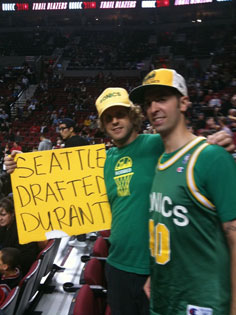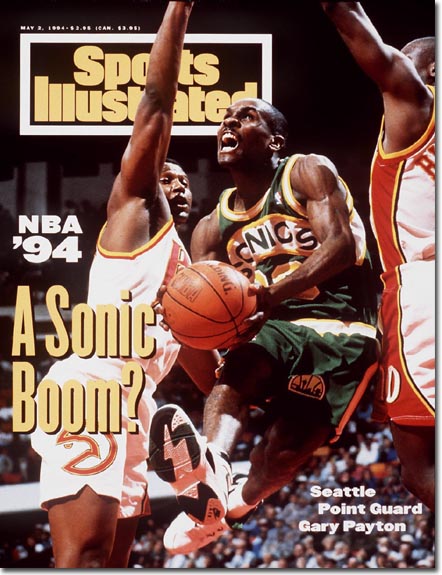 Cavs Archive
Cavs Archive  With a Nod to the Northwest
With a Nod to the Northwest
So… who are you rooting for in the NBA Finals?
Seems like a no-brainer proposition, doesn’t it? LeBron James is playing in the NBA Finals, and for most Cleveland fans rooting against LeBron has become a reflex reaction. LeBron’s opponent seems easy to root for: the young, vibrant Thunder, built the right way through the Draft and led by a seemingly unassuming superstar in Kevin Durant. Natural sympathies would seem to lie with the patiently constructed team and its zealous home crowds over the store-bought superpower with its fickle fan base. Then again, natural sympathies would lie with anyone short of a South American death squad over LeBron.
But before a fan is too hasty to hop onto the OKC bandwagon, let’s cast our thoughts to the Pacific Northwest for a moment.
In a just world, the Finals would box the compass. Miami would be meeting the Seattle SuperSonics, the tropical sweat of South Beach meeting the cool, gray climes of the Emerald City, the gateway to Latin America meeting the gateway to Alaska. It would be Seattle’s first Finals appearance since 1996 with a team poised to add its own chapter to the city’s long and storied NBA tradition.
The SuperSonics began play in 1967. They were Seattle’s first major-league team, arriving a decade ahead of the Seahawks and Mariners. They were by far its most successful. In 41 years the Sonics won six Pacific Division titles, made three trips to the NBA Finals and in 1979 won the city’s only World Championship in any sport (not counting the 1917 Stanley Cup won by the old Metropolitans.) While the Seahawks and Mariners languished in mediocrity the SuperSonics built a legacy of success, going fifteen straight years without a losing record from 1987 through ’02.
They were exciting as well as successful, with explosive and electrifying teams. There was the Championship team with the backcourt of Gus Williams and Dennis Johnson, Jack Sikma at center and Downtown Freddie Brown off the bench. There was the high-scoring trio of Dale Ellis, Tom Chambers and Xavier McDaniel, who in 1987 led the 39-win Sonics on a Cinderella trip to the Western Conference Finals. Then there were the teams Yours Truly came of age with; Gary Payton, Shawn Kemp, Detlef Schrempf and Sam Perkins, the sporting pride of a city that between grunge and Microsoft seemed to dominate the culture at the time.
More than anything, the Sonics were cool. They had a cool name- “Seattle SuperSonics” just seems to glide off the tongue. They had cool uniforms: Seattle’s pre-1995 home jersey, green-and-gold sash on a white field, is elite-class. They had iconic players like the X-Man and the Reign Man, whose jerseys you could wear thousands of miles from the Pacific Northwest. You could play with the Sonics on NBA Live ’95. They had cache.
Like the Browns, the Sonics seemed like the last team in their city that might move. The Seahawks nearly moved to Los Angeles in 1996, the year the Sonics reached the Finals and lost to the Bulls. The Mariners, for years a terrible draw in one of baseball’s ugliest venues, were in a tenuous position in a city that had lost the baseball Pilots after one season. The Sonics, always competitive and always popular, were a rock of stability by comparison. For the most part they were the best thing going in a sports town that has always been a little bit star-crossed.
The Mariners didn’t finish with a winning record until 1992, their fifteenth season of operation. When they finally built a contender in the ‘90s they found their path to the pennant blocked by other American League powers (including the Indians.) In 2001 they finished with the best record in AL history but still couldn’t get past the Yankees in the ALCS. Nearly four decades along, the Mariners have never been to the World Series.
The Seahawks, despite some individual stars like Steve Largent, were usually stuck behind the Broncos and Raiders in the AFC West pecking order. They won just one division title in their first two decades of operation. When they finally reached the Super Bowl in 2005, they fell to the Steelers in a game in which every one of a series of officiating blunders went against them.
 The Sonics also seemed snake-bit at times. The Championship team’s young core fractured as a result of internal squabbles and contract impasses. The 1994 team had the best record in the NBA and an open highway to the Finals in the Jordan-free season and pulled perhaps the biggest first-round el-foldo in playoff history. From 1992 through ’98 the Sonics averaged 59.5 wins but made just one Finals appearance.
The Sonics also seemed snake-bit at times. The Championship team’s young core fractured as a result of internal squabbles and contract impasses. The 1994 team had the best record in the NBA and an open highway to the Finals in the Jordan-free season and pulled perhaps the biggest first-round el-foldo in playoff history. From 1992 through ’98 the Sonics averaged 59.5 wins but made just one Finals appearance.
But the crowning heartbreak came in 2008 with Seattle’s own version of the Move, when Oklahoma tycoon Clay Bennett capped an era of bad faith and broken promises by spiriting the SuperSonics off to the Great Plains. Over the previous decade the city had financed new facilities for the Seahawks and the Mariners while the Sonics continued to play in Key Arena, the NBA’s smallest venue. The arena situation proved to be the opening needed by Bennett, who had designs on moving the Sonics ever since purchasing them in the summer of 2006.
(The Sonics had an odd history in terms of venues. On several occasions they were forced to play postseason games away from their usual home because of scheduling conflicts, even playing a ‘78 Finals game at the Kingdome because the Seattle Center Coliseum was booked for a mobile-home show. It’s hard to believe an NBA team could get kicked out of its own building for the sake of double-wides- and during the Finals at that- but it happened.)
Seattle’s NBA story ended on April 16, 2008, when the Sonics won at Golden State to finish a 20-62 season, worst in franchise history. Rookie Kevin Durant racked up 42 points, 13 rebounds and 6 assists in the victory. Four years later Durant, joined by a dynamic young supporting cast, leads the Oklahoma City Thunder into the Finals- a remarkable turnaround that should have taken place in Seattle.
It’s tough not to notice the similarities with what happened in Cleveland. Like the Browns, the Sonics were the most successful and prestigious team in their city. Like the Browns, the Sonics moved in large part because of their stadium situation. Like the Browns, the Sonics had languished in an old, outdated building while their less successful civic neighbors received sparkling new playpens. And like Browns fans watching despairingly as the new Ravens became a juggernaut, Sonics fans have had to swallow the transformation of their old team into a potential new dynasty.
And really, the Thunder is more or less basketball’s answer to the Baltimore Ravens. They shouldn’t exist. Not to say Oklahoma City shouldn’t have a team. It’s proven to be an outstanding basketball town with one of the loudest and most boisterous home crowds in the game. It’s just that Oklahoma City shouldn’t have the Sonics.
Today Seattle still awaits its redemption, those green-and-gold uniforms still without a team to fill them. Efforts are afoot to do just that, with hedge-fund manager and Pacific Northwest native Chris Hansen working on plans for a new arena to lure either an NBA or NHL team to the Emerald City. (I’d prefer the NHL and a resurrection of the Metropolitans if I were a Seattleite, but nevertheless.) Whatever that team is, it won’t have Durant and Westbrook and Harden, just as the new Browns didn’t come equipped with Ray Lewis and Edward Reed. It won’t be the real SuperSonics. They’re in OKC.
The Seattle angle probably won’t change too many minds in regards to rooting interest in this series- not in this area, at least. It’s a sad story and all, but for many the number-one villain in this melodrama still plays for Miami, wears number 6 and sports a headband that has grown to roughly the size of a woman’s tube-top.
Still, even if your heart is still hardened, at least try to give a passing thought to the folks up in Seattle. We’ve been where they are.
- NBA Announces 2013-2014 Schedule
- Browns Ink Sharknado
- Sharknado A No-Show For Rookie Camp
- Trent Richardson Out Until Training Camp
- Browns Sign Brandon Jackson
- Carrasco Suspended Eight Games
- Browns Add to Wide Receiver Depth with David Nelson
- Browns Need to Learn from Past Draft Mistakes
- Browns Release Chris Gocong and Usama Young
- Browns Missing on Grimes Disappointing, But Not The End
The TCF Forums
- Official- Browns Coach Search/Rumors
Hikohadon (Tuesday, January 21 2014 1:24 PM) - Movies coming out
rebelwithoutaclue (Tuesday, January 21 2014 12:56 PM) - 2015 Recruiting
jclvd_23 (Tuesday, January 21 2014 12:38 PM) - The 2014 Offseason Thread
Larvell Blanks (Tuesday, January 21 2014 12:25 PM) - Chris Grant's first 3 drafts
Kingpin74 (Tuesday, January 21 2014 10:13 AM) - Mike Brown
YahooFanChicago (Monday, January 20 2014 11:15 PM) - 2014 Hoops Hockey Hijinx
jpd1224 (Monday, January 20 2014 4:44 PM) - 2014 Recruiting
jclvd_23 (Monday, January 20 2014 2:26 PM) - Wish List - #4 Pick
Hikohadon (Monday, January 20 2014 1:26 PM) - #1 overall pick Anthony Bennett
TouchEmAllTime (Sunday, January 19 2014 1:28 PM)


